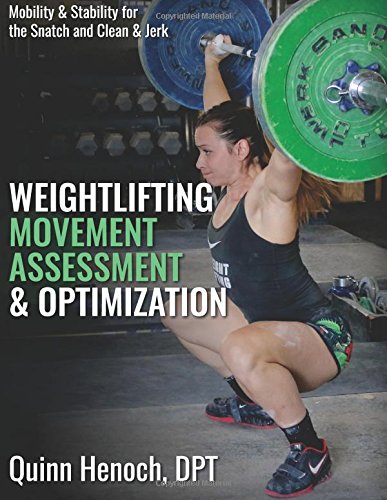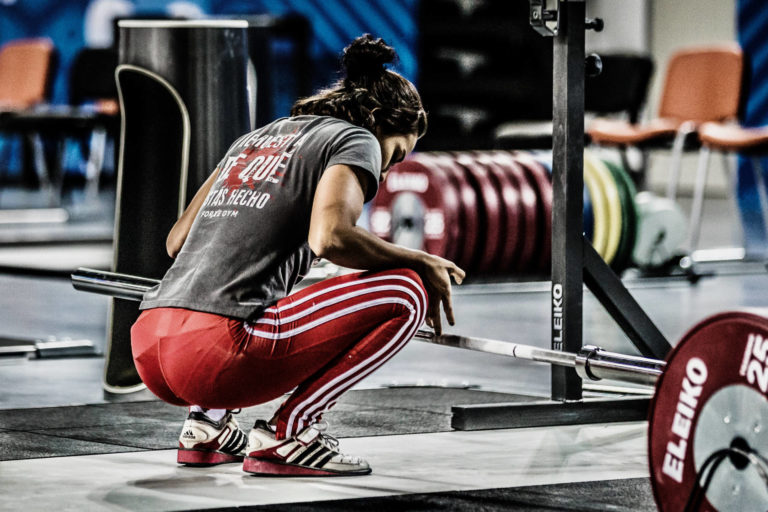STRENGTH SENSEI BOOKSHELF
Weightlifting Movement Assessment and Optimization
A practical guide to achieving optimal movement patterns in weightlifting exercises
Weightlifting is a unique sport because it requires exceptional mobility and stability to perform at the highest levels but also develops these qualities. For some, just performing the classical lifts is enough, but those with flexibility or structural balance issues may need a little help. Providing that help is Weightlifting Movement Assessment and Optimization. By Quinn Henoch, DPT.
One of the issues with many athletes who try weightlifting exercises is that whether it be due to a sedentary lifestyle or structural imbalances developed by playing a sport, it’s often difficult to get into basic positions to perform these lifts. Some coaches don’t even try and just have athletes perform hand power cleans or power snatches or push jerks. Others don’t even try.
This book is not about how to snatch or clean and jerk, but how to ensure that you can attain the optimal positions for the lifts. The author also doesn’t claim that his methods will enable you to lift more weight or rehabilitate injuries, but its promise is to help you perform the lifts with optimal technique—if this results in fewer aches and pains, all the better! When you consider that many elite lifters stop progressing because they have to take extended breaks from performing the lifts because of injuries, adopting a proactive approach to staying healthy may help prolong an athlete’s career and achieve higher performance levels.

Weightlifting Movement Assessment and Optimization is content-dense at 344 pages and extensively illustrated with drawings and photos. The author possesses a Doctor of Physical Therapy and has provided extensive references to his idea. What’s also significant is that Henoch competed in weightlifting. Although he admits he didn’t compete at a high level, he has indeed “walked the talk.”
The book is divided into the following three sections:
Part I: Setting the Foundation.This chapter will be the most challenging for the general audience to get through as it discusses fundamental concepts in human movement that many readers could find dull. In addition, the nature of the material requires you to work through many definitions, as Henoch wants to establish a common language between the author and the reader. But this can be challenging, especially for those who do not have a background in exercise science.
Consider his definition of mobility: “Mobility is the potential for motion of a body segment(s), joint system(s) or muscular system(s), and the ability to produce that motion through a full range. Simply put — the potential ability to produce wanted movement; or even more simply put, mobility is movement potential.” Although the author would certainly want the reader to study this chapter, many readers will be tempted to skip this foundation in human movement theory and skip to the more practical material in Parts II and Part III.

Part II: Screening and Assessment.Charles Poliquin would consider this the Structural Balance assessment section of the book. One difference between what Coach Poliquin taught and Quinn presents is that the book focuses on “screening and assessment of various movement qualities related to the snatch and the clean & jerk.” Thus, it’s not a system that replaces a Structural Balance assessment but complements it.
Part III: Building the Weightlifting Movements.This chapter is the bulk of the book, starting on page 121 and extending to page 334, and can be used as a reference manual. For example, if an athlete is having a specific problem in one aspect of a lift, such as the overhead position of a snatch, they can learn what they can do about it in Chapter 11: Snatch Receiving Position. Also, Quinn has produced many YouTube videos that demonstrate his methods. For the snatch receiving position, you could follow this link to his video entitled, Improving Overhead Squat Movement:
One key human movement principle that Henoch wants to convey to his readers is that “motor skill acquisition is a process.” This translates into these four stages of learning:
1. Unconscious Incompetence
2. Conscious Incompetence
3. Conscious Competence
4. Unconscious Competence
Quinn Henoch, DPT, wrote Weightlifting Movement Assessment and Optimization for weightlifters and weightlifting coaches but has value for any athlete who practices the classical lifts or their variations to enhance performance in their primary sport. Invest in a copy today!
[You can purchase Quinn Henoch’s Weightlifting Movement Assessment and Optimization through Amazon.com.)
